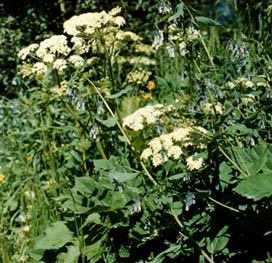

Synonyms: HESPL Heracleum sphondylium var.
lanatum (Michx.) Dorn
HESPM Heracleum sphondylium ssp. montanum (Schleich. ex Gaudin) Briq.
HELA4 Heracleum lanatum Michx.
(Heracleum maximum, Heracleum lanatum Michaux.)
back to the top
Identification: (4)(7)(8)(17)
General Description: Forms a low growing rosette
with a large fleshy taproot in its first year
Stems: Somewhat hairy and grooved
Flowers: White to Cream colored. Tiny with
five petals in umbels which are 6-12 inches. It forms clusters
from ball shaped to flat. It has a interesting, sweet smell. . Opens
from huge green pod atop stems.
Flower stalks grow from 2 to 8 feet.
Blooms: March - May.
Leaves: Made up of three huge maple like leaflets, 1 - 2 ft across. They are also hairy with serrated edges.
Seed: The seed is flattened on one side and
rounded on the other, with distinct ridges.
Cow parsnip is a native, perennial forb that grows from 3.3 to 10 feet
(1-3 m) tall and has broad, flat-topped umbels. It
grows from a stout taproot or a cluster of fibrous roots. Leaves
are 8 to 20 inches (20-50 cm) long and wide. The
egg shaped fruit is 0.32 to 0.48 inch (8-12 mm) long and 0.24 to 0.36
inch (6-9 mm) wide.
Cow parsnip reproduces by seed. Some flowers within an umbel only produce
stamens, while others are hermaphroditic. Secondary umbels develop
synchronously approximately 10 to 14 days after the primary umbel.
Hermaphroditic flower and seed production may be increased by herbivory.
back to the top
Geography: (6)(8)(17)
The common cow parsnip is located mainly in
the Old World, but a few species do exist in grassy places and roadsides
in Europe, Asia and North America. The areas most with the most common
sightings of cow parsnip are represented in RED below.

| AREA | STATUS | REFERENCES |
| Northern Pacific Border | Yes | FEIS |
| Cascade Mountains | Yes | FEIS |
| Southern Pacific Border | Yes | FEIS |
| Sierra Mountains | Yes | FEIS |
| Columbia Plateau | Yes | FEIS |
| Upper Basin and Range | Yes | FEIS |
| Northern Rocky Mountains | Yes | FEIS |
| Middle Rocky Mountains | Yes | FEIS |
| Wyoming Basin | Yes | FEIS |
| Southern Rocky Mountains | Yes | FEIS |
|
|
|
|
|
|
|
|
|
|
|
|
|
|
|
|
|
|
|
|
| Georgia | Yes | Personal Observation |
| Clarke County, Georgia | Yes | Personal Observation |
back to the top
Precautions: (10)(5)
The outer skin, actually considered to be poisonous
by some groups, contains a chemical that sensitizes the skin to light,
which can cause blistering of the lips. Cow parsnip and its relatives
must be handled extremely carefully, because they contain photo toxic compounds
(furanocoumarins), which make the skin sensitive to ultraviolet light,
and therefore, to sunlight. That is why the stalks must be peeled before
being eaten, and, especially for light skinned people, even brushing up
against the hairs of the leaves, and then exposing the skin to sunlight
can cause severe blistering and discoloration of the skin that may remain
for weeks or even months.
back to the top
How to Encounter: (4)(3)(8)(7)
Cow parsnip occurs in a variety of habitats including
woodlands, forest openings, grasslands, and riparian areas such as wet
meadows, stream terraces, alluvial benches, flood plains, and stream and
lake margins. Cow parsnip is a facultative wetland species; it grows
best in moist, shaded areas but can also be found in open woodlands and
clearings. It is shade tolerant, but also grows in some open habitats
such as roadsides and meadows, often in large patches.
It grows best on loam and sandy loam soils derived
from limestone and shale, but occurs on clay, clay loam, and gravely substrates
as well. Cow parsnip occurs in climax communities. Cow parsnip
is a common under story species in quaking aspen community types, which
are often successional in sub alpine forests of the Inter mountain region.
In and around the southern United States, cow parsnip
can be found in a variety of places which are mentioned above. They
are easily spotted along trails, in vacant fields ,and along the roadsides
of most highways. As mentioned before, they do grow easily in a number
of climates and environments as can be seen by the map above. The
species is extremely tolerant and able to grow bountifully most anywhere.
Compiled by John Pickren
jony@bigfoot.com
jony@arches.uga.edu
Ecology 3500-May 1999
University of Georgia